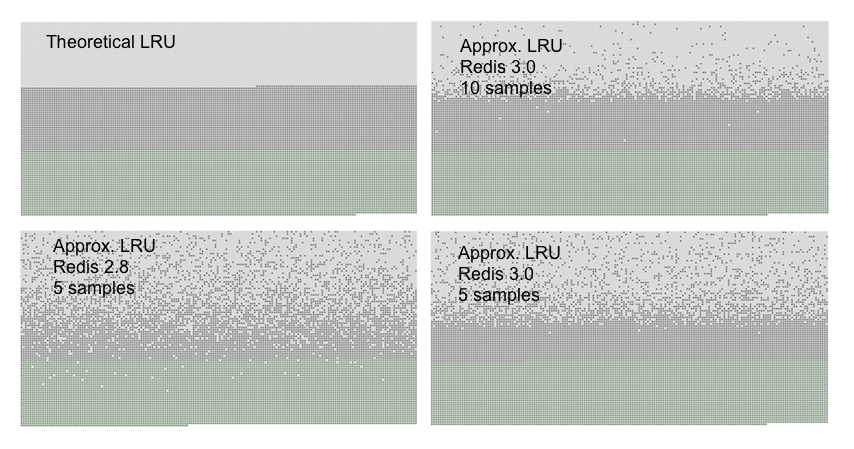Redis的maxmemory支持的内存淘汰机制使得其成为一种有效的缓存方案,成为memcached的有效替代方案。
当内存达到maxmemory后,Redis会按照maxmemory-policy启动淘汰策略。
Redis 3.0中已有淘汰机制:
- noeviction
- allkeys-lru
- volatile-lru
- allkeys-random
- volatile-random
- volatile-ttl
| maxmemory-policy | 含义 | 特性 | |
|---|---|---|---|
| noeviction | 不淘汰 | 内存超限后写命令会返回错误(如OOM, del命令除外) | |
| allkeys-lru | 所有key的LRU机制 | 在所有key中按照最近最少使用LRU原则剔除key,释放空间 | |
| volatile-lru | 易失key的LRU | 仅以设置过期时间key范围内的LRU(如均为设置过期时间,则不会淘汰) | |
| allkeys-random | 所有key随机淘汰 | 一视同仁,随机 | |
| volatile-random | 易失Key的随机 | 仅设置过期时间key范围内的随机 | |
| volatile-ttl | 易失key的TTL淘汰 | 按最小TTL的key优先淘汰 |
其中LRU(less recently used)经典淘汰算法在Redis实现中有一定优化设计,来保证内存占用与实际效果的平衡,这也体现了工程应用是空间与时间的平衡性。
PS:值得注意的,在主从复制模式Replication下,从节点达到maxmemory时不会有任何异常日志信息,但现象为增量数据无法同步至从节点。
Redis 3.0中近似LRU算法
Redis中LRU是近似LRU实现,并不能取出理想LRU理论中最佳淘汰Key,而是通过从小部分采样后的样本中淘汰局部LRU键。
Redis 3.0中近似LRU算法通过增加待淘汰元素池的方式进一步优化,最终实现与精确LRU非常接近的表现。
精确LRU会占用较大内存记录历史状态,而近似LRU则用较小内存支出实现近似效果。
以下是理论LRU和近似LRU的效果对比:

- 按时间顺序接入不同键,此时最早写入也就是最佳淘汰键
- 浅灰色区域:被淘汰的键
- 灰色区域:未被淘汰的键
- 绿色区域:新增写入的键
总结图中展示规律,
- 图1
Theoretical LRU符合预期:最早写入键逐步被淘汰 - 图2
Approx LRU Redis 3.0 10 samples:Redis 3.0中近似LRU算法(采样值为10) - 图3
Approx LRU Redis 2.8 5 samples:Redis 2.8中近似LRU算法(采样值为5) - 图4
Approx LRU Redis 3.0 5 samples:Redis 3.0中近似LRU算法(采样值为5)
结论:
- 通过图4和图3对比:得出相同采样值下,3.0比2.8的LRU淘汰机制更接近理论LRU
- 通过图4和图2对比:得出增加采样值,在3.0中将进一步改善LRU淘汰效果逼近理论LRU
- 对比图2和图1:在3.0中采样值为10时,效果非常接近理论LRU
采样值设置通过maxmemory-samples指定,可通过CONFIG SET maxmemory-samples <count>动态设置,也可启动配置中指定maxmemory-samples <count>
源码解析
1 | int freeMemoryIfNeeded(void){ |
Redis 4.0中新的LFU算法
从Redis4.0开始,新增LFU淘汰机制,提供更好缓存命中率。LFU(Least Frequently Used)通过记录键使用频率来定位最可能淘汰的键。
对比LRU与LFU的差别:
- 在LRU中,某个键很少被访问,但在刚刚被访问后其被淘汰概率很低,从而出现这类异常持续存在的缓存;相对的,其他可能被访问的键会被淘汰
- 而LFU中,按访问频次淘汰最少被访问的键
Redis 4.0中新增两种LFU淘汰机制:
- volatile-lfu:设置过期时间的键按LFU淘汰
- allkeys-lfu:所有键按LFU淘汰
LFU使用Morris counters计数器占用少量位数来评估每个对象的访问频率,并随时间更新计数器。此机制实现与近似LRU中采样类似。但与LRU不同,LFU提供明确参数来指定计数更新频率。
- lfu-log-factor:0-255之间,饱和因子,值越小代表饱和速度越快
- lfu-decay-time:衰减周期,单位分钟,计数器衰减的分钟数
The decay time is the obvious one, it is the amount of minutes a counter should be decayed, when sampled and found to be older than that value. A special value of 0 means: always decay the counter every time is scanned, and is rarely useful.
The counter logarithm factor changes how many hits are needed in order to saturate the frequency counter, which is just in the range 0-255. The higher the factor, the more accesses are needed in order to reach the maximum. The lower the factor, the better is the resolution of the counter for low accesses
2
3
4
5
6
7
8
9
10
11
| factor | 100 hits | 1000 hits | 100K hits | 1M hits | 10M hits |
+--------+------------+------------+------------+------------+------------+
| 0 | 104 | 255 | 255 | 255 | 255 |
+--------+------------+------------+------------+------------+------------+
| 1 | 18 | 49 | 255 | 255 | 255 |
+--------+------------+------------+------------+------------+------------+
| 10 | 10 | 18 | 142 | 255 | 255 |
+--------+------------+------------+------------+------------+------------+
| 100 | 8 | 11 | 49 | 143 | 255 |
+--------+------------+------------+------------+------------+------------+
这两个因子形成一种平衡,通过少量访问 VS 多次访问 的评价标准最终形成对键重要性的评判。